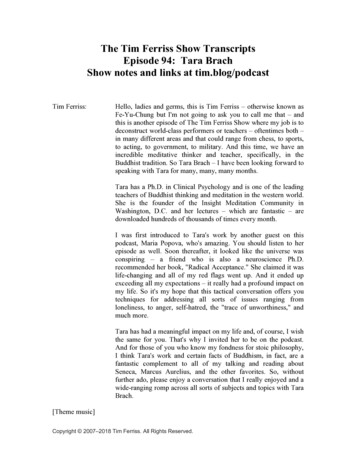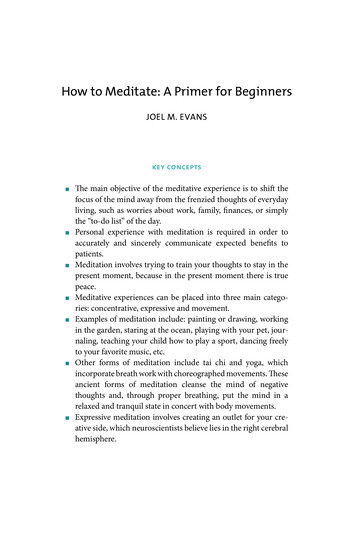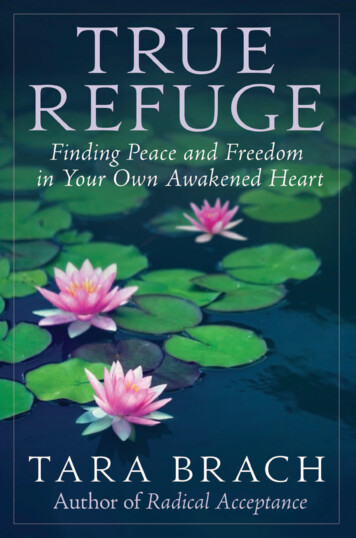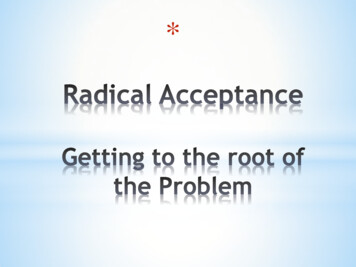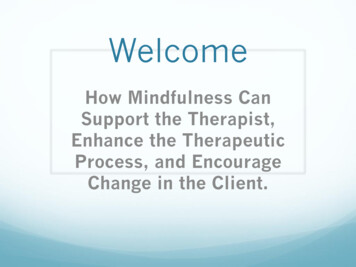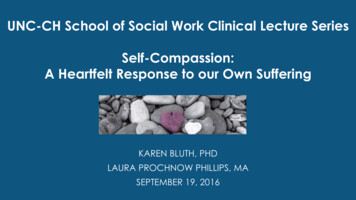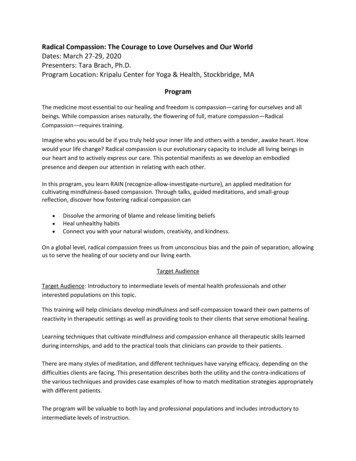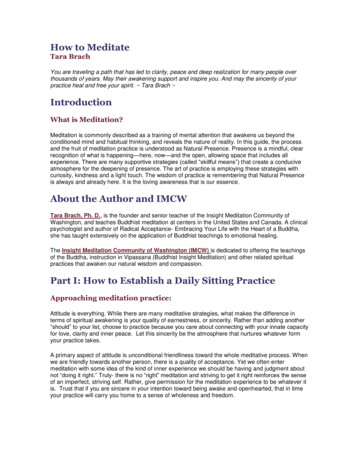
Transcription
How to MeditateTara BrachYou are traveling a path that has led to clarity, peace and deep realization for many people overthousands of years. May their awakening support and inspire you. And may the sincerity of yourpractice heal and free your spirit. Tara Brach IntroductionWhat is Meditation?Meditation is commonly described as a training of mental attention that awakens us beyond theconditioned mind and habitual thinking, and reveals the nature of reality. In this guide, the processand the fruit of meditation practice is understood as Natural Presence. Presence is a mindful, clearrecognition of what is happening—here, now—and the open, allowing space that includes allexperience. There are many supportive strategies (called “skillful means”) that create a conduciveatmosphere for the deepening of presence. The art of practice is employing these strategies withcuriosity, kindness and a light touch. The wisdom of practice is remembering that Natural Presenceis always and already here. It is the loving awareness that is our essence.About the Author and IMCWTara Brach, Ph. D., is the founder and senior teacher of the Insight Meditation Community ofWashington, and teaches Buddhist meditation at centers in the United States and Canada. A clinicalpsychologist and author of Radical Acceptance- Embracing Your Life with the Heart of a Buddha,she has taught extensively on the application of Buddhist teachings to emotional healing.The Insight Meditation Community of Washington (IMCW) is dedicated to offering the teachingsof the Buddha, instruction in Vipassana (Buddhist Insight Meditation) and other related spiritualpractices that awaken our natural wisdom and compassion.Part I: How to Establish a Daily Sitting PracticeApproaching meditation practice:Attitude is everything. While there are many meditative strategies, what makes the difference interms of spiritual awakening is your quality of earnestness, or sincerity. Rather than adding another“should” to your list, choose to practice because you care about connecting with your innate capacityfor love, clarity and inner peace. Let this sincerity be the atmosphere that nurtures whatever formyour practice takes.A primary aspect of attitude is unconditional friendliness toward the whole meditative process. Whenwe are friendly towards another person, there is a quality of acceptance. Yet we often entermeditation with some idea of the kind of inner experience we should be having and judgment aboutnot “doing it right.” Truly- there is no “right” meditation and striving to get it right reinforces the senseof an imperfect, striving self. Rather, give permission for the meditation experience to be whatever itis. Trust that if you are sincere in your intention toward being awake and openhearted, that in timeyour practice will carry you home to a sense of wholeness and freedom.
Friendliness also includes an interest in what arises- be it pleasant sensations or fear, peacefulnessor confusion. And the heart expression of friendliness is kindness — regarding the life within andaround us with care.Creating a container for practice:It helps to have a regular time and space for cultivating a meditation practice.Setting a time - Morning is often preferred because the mind may be calmer than it is later in theday. However, the best time is the time that you can realistically commit to on a regular basis. Somepeople choose to do two or more short sits, perhaps one at the beginning and one at the end of theday.Deciding in advance the duration of your sit will help support your practice. For many, the chosentime is between 15-45 minutes. If you sit each day, you may experience noticeable benefits (e.g.,less reactivity, more calm) and be able to increase your sitting time.Finding a space - If possible, dedicate a space exclusively to your daily sitting. Choose a relativelyprotected and quiet space where you can leave your cushion (or chair) so that it is always there toreturn to. You may want to create an altar with a candle, inspiring photos, statues, flowers, stones,shells and/or whatever arouses a sense of beauty, wonder and the sacred. These are notnecessary, but are beneficial if they help create a mood and remind you of what you love.Set your intention:There is a Zen teaching that says “The most important thing is remembering the most importantthing.” It is helpful to recall at the start of each sitting what matters to you, what draws you tomeditate. Take a few moments to connect in a sincere way with your heart’s aspiration. You mightsense this as a prayer that in some way dedicates your practice to your own spiritual freedom, andthat of all beings.Set your posture:Alertness is one of the two essential ingredients in every meditation. Sit on a chair, cushion, orkneeling bench as upright, tall and balanced as possible. A sense of openness and receptivity is thesecond essential ingredient in every meditation, and it is supported by intentionally relaxing obviousand habitual areas of tension. Around an erect posture, let the rest of your skeleton and muscleshang freely. Let the hands rest comfortably on your knees or lap. Let the eyes close, or if you prefer,leave the eyes open, the gaze soft and receptive.Please don’t skip the step of relaxing/letting go! You might take several full deep breaths, and witheach exhale, consciously let go, relaxing the face, shoulders, hands, and stomach area. Or, you maywant to begin with a body scan: start at the scalp and move your attention slowly downward,methodically relaxing and softening each part of the body. Consciously releasing body tension willhelp you open to whatever arises during your meditation.The Basic Practice:Natural PresencePresence has two interdependent qualities of recognizing, or noticing what is happening, andallowing whatever is experienced without any judgment, resistance or grasping. Presence is our
deepest nature, and the essence of meditation is to realize and inhabit this whole and lucidawareness.We practice meditation by receiving all the domains of experience with a mindful, open attention.These domains include breath and sensations; feelings (pleasant, unpleasant and neutral); senseperceptions, thoughts and emotions; and awareness itself.In the essential practice of meditation there is no attempt to manipulate or control experience.Natural Presence simply recognizes what is arising (thoughts, feelings, sounds, emotions) andallows life to unfold, just as it is. As long as there is a sense of a self making an effort and doing apractice, there is identification with a separate and limited self. The open receptivity of NaturalPresence dissolves this sense of a self “doing” the meditation.Knowing the difference between Natural Presence and “skillful means”or supports for practice:Because our minds are often so busy and reactive, it is helpful to develop skillful means that quietthe mind and allow us to come home to the fullness of Natural Presence. These supports for practicehelp us to notice and relax thoughts and physical tension. They involve a wise effort that un-does ourefforting!You might consider yourself as a contemplative artist, with a palette of colors (supportive strategies)with which to work in creating the inner mood that is most conducive for the clarity and openness ofpresence. These colors can be applied with a light touch. Experiment and see what works best foryou, and don’t confuse these methods (such as following the breath) with the radical and liberatingpresence that frees and awakens our spirit. Regardless of what skillful means you employ, createsome time during each sitting when you let go of all “doings” and simply rest in Natural Presence.Discover what happens when there is no controlling or efforting at all, when you simply let life be justas it is. Discover who you are, when there is no managing of the meditation.Skillful Means: Our supports for practicePresence is supported by a calm and collected mind, a mindful awareness and an open heart. Thefollowing strategies cultivate these capacities:Establish an embodied presence—senses awake!You might take a few minutes at the beginning of the sitting (or anytime during the sitting or day) tointentionally awaken all the senses. Scan through the body with your attention, softening andbecoming aware of sensations from the inside out. Listen to sounds and also include the scent andthe feel of the space around you in and outside of the room. While the eyes may be closed, stillinclude the experience of light and dark, and imagine and sense the space around you. Explorelistening to and feeling the entire moment–to-moment experience, with your senses totally open.Choose a home base—a primary anchor or subject of meditation.It is helpful to select a home base (or several anchors) that allow you to quiet and collect the mind,and to deepen embodied presence. Useful anchors are: The breath as it enters and leaves the nostrils.Other physical changes during breathing, e.g., the rise and fall of the chest.Other physical sensations as they arise, e.g. the sensations in the hands, or through thewhole body.
Sounds as they are experienced within or around you.Listening to and feeling one’s entire experience, (i.e., receiving sounds and sensations inawareness).Remindfulness—"coming back" and "being here"Mindfulness is the awareness that emerges through paying attention on purpose and nonjudgmentally to the unfolding of moment to moment experience. We train in mindfulness byestablishing an embodied presence and learning to see clearly and feel fully the changing flow ofsensations, feelings (pleasantness and unpleasantness), emotions and sounds.A metaphor offered by psychiatrist and author, Dan Siegel, is helpful. Imagine your awareness as agreat wheel. At the hub of the wheel is mindful presence, and from this hub, an infinite number ofspokes extend out to the rim. Your attention is conditioned to leave presence, move out along thespokes and affix itself to one part of the rim after another. Plans for dinner segue into a disturbingconversation, a self-judgment, a song of the radio, a backache, the feeling of fear. Or your attentiongets lost in obsessive thinking circling endlessly around stories and feelings about what is wrong. Ifyou are not connected to the hub, if your attention is trapped out on the rim, you are cut off from yourwholeness and living in trance.Training in mindfulness allows us to return to the hub and live our moments with full awareness.Through the practice of "coming back" we notice when we have drifted and become lost in thought,and we recall our attention back to a sensory based presence. This important capacity is developedthrough the following steps: Set your intention to awaken from thoughts—mental commentary, memories, plans,evaluations, stories—and rest in non-conceptual presence.Gently bring attention to your primary anchor, letting it be in the foreground while stillincluding in the background the whole domain of sensory experience. For instance youmight be resting in the inflow and outflow of the breath as your home base, and also bemindful of the sounds in the room, a feeling of sleepiness, an itch, heat.When you notice you have been lost in thought, pause and gently re-arrive in your anchor,mindful of the changing moment-to-moment experience of your senses.It can be helpful to remember that getting distracted is totally natural- just as the body secretesenzymes, the mind generates thoughts! No need to make thoughts the enemy; just realize that youhave a capacity to awaken from the trance of thinking. When you recognize that you have been lostin thought, take your time as you open out of the thought and relax back into the actual experience ofbeing Here. You might listen to sounds, re-relax your shoulder, hands and belly, relax your heart.This will allow you to arrive again in mindful presence at the hub, senses wide open, letting yourhome base be in the foreground. Notice the difference between any thought and the vividness of thisHere-ness!As the mind settles, you will have more moments of “being here,”’ of resting in the hub and simplyrecognizing and allowing the changing flow of experience. Naturally the mind will still sometimes loseitself on the rim, and at these times, when you notice, you again gently return to the hub—“comingback,” and “being here” are fluid facets of practice.The more you inhabit the alert stillness at the center of the wheel and include in mindfulnesswhatever is happening, the more the hub of presence becomes edgeless, warm and bright. In themoments when there is no controlling of experience—when there is effortless mindfulness— youenter the purity of presence. This is “Natural Presence.” The hub, spokes and rim are all floating inyour luminous open awareness.
Practice metta to soften and open the heart.Metta practice, also called lovingkindness meditation, cultivates both a loving heart and a collected,settled mind. The practice uses specific phrases to send loving and kind wishes to yourself, lovedones, neutral persons, difficult people and to all beings everywhere, without exception. You mightchoose three or four of the below, or create whatever phrases resonate for you:May I be filled with lovingkindness.May I feel safe from harm.May I accept myself just as I am.May I be peaceful and at ease.May I be happy.Spend a few minutes or more offering the phrases to yourself, taking the time to imagine and directlyfeel the experience the phrases invoke. Then do the same as you offer it to the others mentionedabove. You can bring in the metta practice at the beginning, end or during any part of themeditation. For some people, it can be beneficial to emphasize metta as a primary practice—especially when there has been trauma or great self-aversion. This skillful means is a beautiful wayto awaken the heart.Developing concentrationBringing attention to a primary subject or anchor can lead to a concentrated focus that naturallycalms and collects the mind. This concentration can be deepened by intentionally aiming andsustaining a focused attention with your chosen anchor. When cultivating concentration, the anchorshould be one that has a pleasant or at least neutral feeling tone.Concentration supports mindfulness and requires a relaxed attention. There is often a subtle (orovert) sense of making an effort to sustain concentration, of striving to control the mind and makesomething happen. It is important to not become caught in a striving effort. It is easy to be seducedinto trying to achieve something, such as staying with the breath for much of the sitting, and thenevaluating what is happening as a “good” or “not good” meditation. Mistaking a focus on the breathfor meditation is like fixating on the quality of your hiking boots, and not really being awake of thenatural world you are inhabiting!Concentration helps quiet the mind and without some quieting, mindfulness is difficult to sustain. Italso can lead to states of rapture and deep peace. Yet without a mindful presence, concentrationbears no fruit. The key to concentration is remembering your intention towards presence, and thenfocusing on your chosen subject for meditation with a soft, clear and relaxed attention.RAIN—healing emotional sufferingThe mindful presence that helps release emotional suffering is summarized by the acronym RAIN. R-Recognize - notice what is arising (fear, hurt, etc.)A-Allow - agree to “be with it,” to “let it be.”I-Investigate - in a non-analytic way, get to know how the body, heart and mind experiencesthese energies. You might inquire by asking yourself one or more of the following questions:“What is happening?” “Where am I feeling this in my body?” “What wants attention?” “Whatwants acceptance?” The “I” is also Intimacy: experiencing difficult sensations and emotionswith a direct, gentle, kind attention; and offering compassion to the place of vulnerability.
N-Non-identification, or not having your sense of Being defined by, possessed by or linkedto any emotion. In other words, not taking it personally! The “N” is also Natural Presence, ahomecoming to the loving awareness that is our essence.Practice Self-InquiryInquiry (questions like “What is happening?”) can bring attention in a direct way to the changing flowof experience and reveal the truth of impermanence and the empty (self-less) nature of sights,sounds, thoughts, emotions and feelings. Self- inquiry extends this process by turning awarenessback on itself. Classical questions include: “Who am I?” “What am I?” “Who or what is aware?” “Whoor what is listening to sound” “Who or what is looking out through these eyes?”Self-Inquiry is best done when the mind is relatively quiet and senses awake. Ask a question andlook back towards awareness, towards that which is aware. After asking, relax with an embodiedpresence, open, not in any way pursuing an answer with your intellect. By enrolling the naturalinterest, energy and receptive attention of inquiry, the very nature of awareness is revealed.Part 2: Common Issues for MeditatorsGetting lost in thoughtAt first, you may be surprised at how active and uncontrolled your mind is. Don’t worry - you arediscovering the truth about the state of most minds! Accept and patiently “sit with” whatever comesup. There is no need to get rid of thoughts; this is not the purpose of meditation. Rather, we arelearning to recognize when thinking is happening so we are not lost in a trance—believing thoughtsto be reality, becoming identified with thoughts.Because we are so often in a thinking trance, it is helpful to quiet down some. Just like a body ofwater stirred up by the winds, after being physically still for a while, your mind will gradually calmdown. To support that quieting, at the beginning of a sitting it can be helpful to relax and practiceRemindfulness—gently bringing your attention back again and again to your home base in thesenses.It takes practice to distinguish the trance of thinking - fantasy, planning, commentary, dreamy states from the presence that directly receives the changing experience of this moment. Establishing anembodied awareness and letting your anchor be in the foreground is a good way to become familiarwith the alive, vibrant mystery of Here-ness, of presence.The Five Classic Challenges (called “hindrances” in Buddhist texts): Grasping: wanting more (or something different) from what’s present right now.Aversion: fear, anger, any form of pushing away.Restlessness: jumpy energy, agitation.Sloth and torpor: sleepy, sinking states of mind and body.Doubt: a mind-trap that says, “it’s no use, this will never work, maybe there’s an easier way”.These are universal body-mind energies experienced by all humans. It is important to recognize thatthey are not a “problem.” The energies become “hindrances” because our conditioned habit is toignore, resist, judge or otherwise try to control them. And yet when met with mindfulness and care,these same energies become a gateway to increased aliveness and spiritual awakening.
During sitting practice, if you encounter one of these challenging energies, it may be useful to nameit silently to yourself, e.g., “grasping, grasping” or “fear, fear.” If it is strong, rather than pulling away,let your intention be to bring your full attention to what is arising. Feel what is happening assensations in your body, neither getting lost in the experience nor pushing it away. As indicatedthrough the RAIN acronym, investigate what is arising and meet the experience with an intimate,compassionate attention. When it dissipates, return to the primary anchor of your meditation, or restin Natural Presence.Sometimes the energy is too strong, and it is not wise or compassionate to try to stay present with it.This is particularly true if you have been traumatized and are experiencing deep fear or anger. If itfeels like “too much,” shift the attention to something that brings a sense of balance, safety and/orlove. You might open your eyes, remind yourself of where you are, listen to sounds, relax againthrough your body. You might bring to mind someone who loves and understands you, and sensetheir care surrounding you. You might reflect on the Buddha or the bodhisattva of compassion,Jesus, Great Spirit, your grandmother, your dog or a favorite tree. You might offer phrases oflovingkindness to places of vulnerability. Meditate on any expression of loving presence that helpsyou feel less separate or afraid.If you encounter these kinds of difficult emotional energies regularly you might ask a teacher ortherapist familiar with meditation to accompany you as you learn to navigate what feels most intense.Physical painIn addition to mental busyness and emotional challenges, it is inevitable that we all experience acertain amount of unpleasant physical sensations. If you are not used to the posture, there may besome discomfort in simply sitting still. In addition, as your attention deepens, you might becomeaware of tensions in the body that were ignored because of being preoccupied by thought. Or, youmight be injured or sick, and become more directly aware of the natural unpleasant sensationsaccompanying that condition.Meditating with physical discomfort is the same as the process of presence with emotional difficulty.Let your intention be to meet the unpleasantness with a gentle attention, noticing how it isexperienced in the body and how it changes. Allow the unpleasantness to float in awareness, to besurrounded by soft presence. To establish that openness you might include in your attention sounds,and/or other parts of the body that are free from pain. Breathe with the experience, offering aspacious and kind attention. Be aware of not only the physical sensations, but how you are relatingto them. Is there resistance? Fear? If so, let these energies be included with a forgiving and mindfulattention.If the physical unpleasantness is intense and wearing you out, direct your attention for a while tosomething else. It is fine to mindfully shift your posture, or to use a skillful means like phrases oflovingkindness or listening to sounds as a way to discover some space and resilience. You don’tneed to “tough it out.” That is just another ego posture that solidifies the sense of separate self. In asimilar vein, you don’t have to “give up.” Instead, discover what allows you to find a sense of balanceand spaciousness, and when you are able, again allow the immediate sensations to be received withpresence.Part 3: Sustaining a Meditation PracticeHere are a few helpful hints for sustaining your sitting practice: Sit every day, even if it's for a short period. Intentionally dedicate this time of quieting—it is agift to the soul!
A few times during each day, pause. Establish contact with your body and breath, feeling thealiveness that is Here.Pause more and more—the space of a pause will allow you to come home to your heart andawareness.Reflect regularly on your aspiration for spiritual awakening and freedom—your own and thatof all beings.Remember that, like yourself, everyone wants to be happy and nobody wants to suffer.Practice regularly with a group or a friend.Use inspiring resources such as books, CD’s or web-accessed dharma talks.Study the Buddhist teachings (e.g., the 4 Noble Truths, the Noble 8-Fold Path).Sign up for a retreat—one day, a weekend, or longer. The experience will deepen yourpractice and nourish spiritual awakening.If you miss practice for a day, a week, or a month, simply begin again.If you need guidance, ask for help from an experienced meditator or teacher.Don’t judge your practice -- rather, accept what unfolds and trust your capacity to awakenand be free!Live with a reverence for life—committed to non-harming, to seeing, honoring and servingthe sacred in all beings.You are traveling a path that has led to clarity, peace and deep realization for many people overthousands of years. May their awakening support and inspire you. And may the sincerity of yourpractice heal and free your spirit. Tara Brach ResourcesRecommended books Tara Brach: Radical Acceptance: Embracing Your Life With the Heart of a Buddha , 2003.Tara Brach: True Refuge: Finding Peace and Freedom in Your Own Awakened Heart. 2013.Ven. Henepola Gunaratana: Mindfulness in Plain English, Updated and Expanded Edition ,2002.Jack Kornfield: The Wise Heart: A Guide to the Universal Teachings of Buddhist Psychology, 2008.Sharon Salzberg: Lovingkindness: The Revolutionary Art of Happiness, 1995.Recommended Meditation CD: Tara Brach: Radical Acceptance- Guided Meditations, 2007.Web resources: Insight Meditation Community of WashingtonAccess to InsightBhavana Society, Forest Monastery and Retreat CenterCambridge Insight Meditation CenterNew York InsightSpirit Rock Meditation CenterInsight Meditation Society
Tara Brach, Ph. D., is the founder and senior teacher of the Insight Meditation Community of Washington, and teaches Buddhist meditation at centers in the United States and Canada. A clinical psychologist and author of Radical Acceptance- Embracing Your Life with the Heart of a Buddha,
